An Enhanced Detection Method of PCB Defect Based on D-DenseNet (PCBDD-DDNet)
Abstract
:1. Introduction
- (1)
- To address the issues of low detection accuracy, difficulty in detecting small defects, and limited usability in existing PCB inspection methods, a PCB defect detection method based on D-DenseNet (PCBDD-DDNet) is proposed in this paper.
- (2)
- The D-DenseNet model that combines two powerful deep neural networks, CDBN and DenseNet, is proposed. It employs the output of the third layer from CDBN as the input for DenseNet. Following the fourth Dense Block of DenseNet, a concatenation layer is introduced to merge the low-level features extracted by CDBN with the high-level features extracted by DenseNet. This further enhances the model’s performance.
- (3)
- A multi-scale feature extraction module is used to extract feature maps at different levels of the network. Filters of sizes 3 × 3, 5 × 5, and 7 × 7 are added on three paths in the CDBN network, multi-scale feature extraction network, and DenseNet network, respectively, to effectively capture information at different scales. Subsequently, 1 × 1 convolutional kernels are employed to merge these features for feature extraction and classification purposes.
- (1)
- By introducing a combination of deep learning network structures (CDBN and DenseNet), this method achieves high accuracy and comprehensive feature extraction in PCB defect detection. This technical contribution indicates the application of deep learning in the field of multimedia, especially in image processing and analysis, playing a crucial role in industrial production. This provides strong support for the practical application of multimedia technology in manufacturing, expanding its scope in industrial production.
- (2)
- The introduction of a multi-scale module extracts image features through filters of different scales. This innovative application is particularly important in the multimedia field, emphasizing the importance of considering multiple levels and scales in image analysis. This not only achieves good results in PCB defect detection but also provides insights for image analysis in other multimedia fields, potentially advancing the development of multimedia technology in various application areas.
- (3)
- Through experimentation on publicly available PCB datasets, the method demonstrates significant achievements in PCB defect detection, with a mean Average Precision (mAP) reaching 93.24%, and accuracy surpassing other classical networks. This indicates the high efficiency of the method in practical applications. From a practical application perspective, this technical contribution provides an efficient and accurate method for PCB defect detection in manufacturing. It is expected to be widely applied in the field of electronic product manufacturing, contributing to improved quality control and reduced defect rates, thereby enhancing the competitiveness of the entire manufacturing industry.
2. Methods
2.1. Design of PCBDD-DDNet
2.2. Constructing the D-DenseNet Network
2.2.1. Data Dimension Transformation
2.2.2. Network Integration
2.2.3. Concatenation of Feature Vectors
2.2.4. Construction of the New Network
2.3. Multi-Scale Feature Extraction
2.4. Adafactor Optimization Function
- (1)
- Calculate the moving average of the gradient square:
- (2)
- Calculate the first-order moment estimate of the gradient:
- (3)
- Calculate the adaptive learning rate and regularization:
- (4)
- Calculate the parameter update:
2.5. L2 Regularization
2.6. Online Hard Example Mining (OHEM)
| Algorithm 1: The specific implementation process of OHEM |
| Input: Training dataset (including images and labels), network model, loss function, upper limit for positive samples, positive-to-negative sample ratio, threshold. |
| #Training Process For each training epoch: Randomly select a mini-batch of training samples. #Positive Sample Mining For each sample: Input the image into the network and obtain predicted values for each pixel. Filter out positive sample pixel points with a class prediction confidence of 1.0. |
| For the remaining samples: Select samples with predicted values confidence greater than the threshold. Set the confidence of these samples’ predicted values to 1.0. Calculate the loss function for samples with predicted values confidence less than the threshold. |
| #Positive-to-Negative Sample Ratio Control For samples with a number of positive sample pixels exceeding the upper limit, randomly select the upper limit number of positive samples. |
| For negative sample pixels, randomly select a number of negative samples equal to the product of the number of positive samples and the positive-to-negative sample ratio. |
| Calculate the loss function. |
| Update network parameters. |
| End training |
3. Results
3.1. Experimental Environment
3.2. Dataset
3.3. Evaluation Indicators
- (1)
- Dataset Testing: experimental validation is conducted on publicly available PCB datasets to demonstrate the effectiveness of the PCBDD-DDNet method.
- (2)
- Performance Metrics: The primary performance metric used is mAP (mean Average Precision), with additional consideration of other metrics such as accuracy, Precision, and Recall. This comprehensive evaluation helps assess the overall performance of the method.
- (3)
- Comparison with Other Methods: comparative analysis is performed with existing classical deep learning methods to validate the accuracy of the proposed approach.
3.4. Experiment Results Analysis
3.4.1. Network Concatenation Performance Analysis
- (1)
- The D-DenseNet network obtained by concatenating the DBN network and the DenseNet network exhibited an improved detection performance.
- (2)
- The detection accuracy reached 91.43%, which is an increase of 4.86% compared to the CDBN network and a 0.61% improvement compared to the DenseNet network.
- (3)
- Moreover, the concatenated D-DenseNet network showed improvements of 1.51% in Recall rate and 3.98% in Average Precision compared to the CDBN network, and improvements of 0.73% in Recall rate and 0.75% in Average Precision compared to the DenseNet network.
- (4)
- The experiment demonstrated the enhanced performance of the D-DenseNet network achieved by concatenating the CDBN and DenseNet networks.
3.4.2. Performance Analysis of Multi-Scale Feature Extraction Network
- (1)
- Compared to the original, unimproved D-DenseNet network, the D-DenseNet network with the added multi-scale feature extraction module exhibited a better detection performance, achieving a detection accuracy of 91.90%, which was a 0.47% improvement over the original D-DenseNet network.
- (2)
- Furthermore, in terms of Recall and Average Precision, the D-DenseNet network with the multi-scale feature extraction module showed improvements of 1.19% and 1.04%, respectively, confirming the effectiveness of the multi-scale feature extraction module.
3.4.3. Performance Analysis of Adafactor Optimization Function and L2 Regularization
- (1)
- Compared to the original unimproved D-DenseNet network, the D-DenseNet network with only the addition of the Adafactor optimization function had improved Precision by 0.24%, and the D-DenseNet network with only the addition of L2 regularization has improved the Precision by 0.29%.
- (2)
- The D-DenseNet network with both the Adafactor optimization function and L2 regularization showed better detection performance, achieving a Precision rate of 91.88%, which was a 0.45% improvement compared to the original unimproved D-DenseNet network.
- (3)
- Additionally, in terms of Recall and Average Precision, the D-DenseNet network with both the Adafactor optimization function and L2 regularization also outperformed the original unimproved network.
- (4)
- The experimental results demonstrated the effectiveness of the Adafactor optimization function and L2 regularization, as well as the continued improvement in network performance when both the Adafactor optimization function and L2 regularization are added simultaneously.
3.4.4. Performance Analysis of Hard Sample Mining Mechanism OHEM
- (1)
- Compared to the original unimproved D-DenseNet network, the D-DenseNet network with the introduction of the hard example mining mechanism (OHEM) exhibited a better detection performance.
- (2)
- The detection Precision rate reached 92.01%, which was an improvement of 0.58%. Additionally, there was an enhancement of 1.12% in Recall rate and 0.79% in Average Precision.
- (3)
- The experiment demonstrated that the OHEM mechanism for mining hard examples can enhance the network’s detection performance.
3.4.5. Comprehensive Analysis of Network Performance
- (1)
- Compared to the original D-DenseNet network without any improvements, the D-DenseNet networks enhanced with all the modifications in the text exhibited a better detection performance.
- (2)
- The detection accuracy reached 92.34%, showing an improvement of 0.91%. Additionally, the Recall rate and Average Precision reached 94.09% and 93.24%, respectively, showcasing improvements of 1.63% and 1.50% compared to the original D-DenseNet network.
- (3)
- These results validated the detection performance of the PCBDD-DDNet method.
3.4.6. Comparison of D-DenseNet Network with Other Classic Algorithms
- (1)
- The proposed D-DenseNet network in this paper outperformed other networks in terms of overall defect recognition performance, achieving higher evaluation metrics for Precision, Recall, and Average Precision.
- (2)
- Compared to using the CDBN network alone, the proposed network in this chapter achieved a 2.14% increase in Precision, a 5.77% increase in Recall, and a 4.78% increase in Average Precision.
- (3)
- Compared to using the DenseNet network alone, the proposed network in this chapter achieved a 1.36% increase in Precision, a 1.46% increase in Recall, and a 1.55% increase in Average Precision.
- (4)
- It can be seen that the proposed D-DenseNet achieved the highest detection accuracy, with a 93.24% mAP value, which is 4.79%, 3.96%, 2.60%, 1.58%, and 1.21% superior compared to RetinaNet, SSD, YOLOv3, RetinaNet, Faster-RCNN, and FPN, respectively. Meanwhile, D-DenseNet outperformed the other four compared models in P, R, and mAP.5:.95. Based on the comparison, the D-DenseNet model exhibited a significant advantage in terms of detection accuracy. Overall, the proposed network in this chapter demonstrates superior defect recognition capabilities.
3.4.7. Display of Detection Effect
4. Conclusions
Author Contributions
Funding
Data Availability Statement
Acknowledgments
Conflicts of Interest
Abbreviations
| Abbreviations | Explanations |
| output of layer l | |
| nonlinear transformation function of layer l | |
| initial number of channels | |
| growth rate per layer | |
| l | the layer |
| moving average of the gradient square at the previous step | |
| decay rate of the moving average | |
| gradient at the current time step | |
| α | learning rate |
| ∈ | a small constant |
| γ | regularization parameter |
| parameter vector | |
| updated parameter vector | |
| λ | regularization coefficient |
| L2 norm | |
| model’s predicted value | |
| actual value | |
| the loss function used to measure the difference between the predicted and actual values | |
| TP | number of samples correctly classified as attacks |
| FP | number of samples incorrectly classified as attacks |
| TN | number of samples correctly classified as normal |
| FN | number of samples incorrectly classified as normal |
| A | accuracy |
| P | Precision |
| R | Recall |
| F1 | the harmonic mean of Precision and Recall |
| AP | Average Precision |
| mAP | mean Average Precision |
References
- Ling, Q.; Isa, N.A.M. Printed Circuit Board Defect Detection Methods Based on Image Processing, Machine Learning and Deep Learning: A Survey. IEEE Access 2023, 11, 15921–15944. [Google Scholar] [CrossRef]
- Chen, I.C.; Hwang, R.C.; Huang, H.C. PCB Defect Detection Based on Deep Learning Algorithm. Processes 2023, 11, 775. [Google Scholar] [CrossRef]
- Park, J.H.; Kim, Y.S.; Seo, H.; Cho, Y.J. Analysis of Training Deep Learning Models for PCB Defect Detection. Sensors 2023, 23, 2766. [Google Scholar] [CrossRef]
- Ren, Z.; Fang, F.; Yan, N.; Wu, Y. State of the art in defect detection based on machine vision. Int. J. Precis. Eng. Manuf.-Green Technol. 2022, 9, 661–691. [Google Scholar] [CrossRef]
- Aggarwal, N.; Deshwal, M.; Samant, P. A survey on automatic printed circuit board defect detection techniques. In Proceedings of the 2022 2nd International Conference on Advance Computing and Innovative Technologies in Engineering (ICACITE), Greater Noida, India, 28–29 April 2022; pp. 853–856. [Google Scholar]
- Griffin, P.M.; Villalobos, J.R.; Foster, J.W., III; Messimer, S.L. Automated visual inspection of bare printed circuit boards. Comput. Ind. Eng. 1990, 18, 505–509. [Google Scholar] [CrossRef]
- Putera, S.H.I.; Dzafaruddin, S.F.; Mohamad, M. MATLAB based defect detection and classification of printed circuit board. In Proceedings of the 2012 Second International Conference on Digital Information and Communication Technology and It’s Applications (DICTAP), Bangkok, Thailand, 16–18 May 2012; pp. 115–119. [Google Scholar]
- Li, Y.; Li, S. Defect detection of bare printed circuit boards based on gradient direction information entropy and uniform local binary patterns. Circuit World 2017, 43, 145–151. [Google Scholar] [CrossRef]
- Anoop, K.P.; Sarath, N.S.; Kumar, V.V. A review of PCB defect detection using image processing. Intern. J. Eng. Innov. Technol. 2015, 4, 188–192. [Google Scholar]
- Ren, J.; Gabbar, H.A.; Huang, X.; Saberironaghi, A. Defect Detection for Printed Circuit Board Assembly Using Deep Learning. In Proceedings of the 2022 8th International Conference on Control Science and Systems Engineering (ICCSSE), Guangzhou, China, 14–16 July 2022; pp. 85–89. [Google Scholar]
- Kuang, Y.; Ouyang, G.; Xie, H.; Hong, S.; Yang, J. Features learning method for PCB assembling defects inspection based on statistical analysis. Appl. Res. Comput. 2010, 27, 775–777+783. [Google Scholar]
- Gaidhane, V.H.; Hote, Y.V.; Singh, V. An efficient similarity measure approach for PCB surface defect detection. Pattern Anal. Appl. 2018, 21, 277–289. [Google Scholar] [CrossRef]
- Annaby, M.H.; Fouda, Y.M.; Rushdi, M.A. Improved normalized cross-correlation for defect detection in printed-circuit boards. IEEE Trans. Semicond. Manuf. 2019, 32, 199–211. [Google Scholar] [CrossRef]
- Tsai, D.M.; Huang, C.K. Defect detection in electronic surfaces using template-based Fourier image reconstruction. IEEE Trans. Compon. Packag. Manuf. Technol. 2018, 9, 163–172. [Google Scholar] [CrossRef]
- Cho, J.W.; Seo, Y.C.; Jung, S.H.; Jung, H.K.; Kim, S.H. A study on real-time defect detection using ultrasound excited thermography. J. Korean Soc. Nondestruct. Test. 2006, 26, 211–219. [Google Scholar]
- Wu, X.; Ge, Y.; Zhang, Q.; Zhang, D. PCB defect detection using deep learning methods. In Proceedings of the 2021 IEEE 24th International Conference on Computer Supported Cooperative Work in Design (CSCWD), Dalian, China, 5–7 May 2021; pp. 873–876. [Google Scholar]
- Raffik, R.; Sabitha, B.; Arunprasanth, D.; Karthikeyan, E.; Padmanaaban, A.G.; Prasanth, V.S. Automated PCB Defect Identification System using Machine Learning Techniques. In Proceedings of the 2023 2nd International Conference on Advancements in Electrical, Electronics, Communication, Computing and Automation (ICAECA), Tianjin, China, 4–7 August 2023; pp. 1–5. [Google Scholar]
- Hu, Y.; Tan, Y. State and Development of Automatic Optical Inspection Applications in China. Microcomput. Inf. 2006, 22, 143–146. [Google Scholar]
- Zakaria, S.S.; Amir, A.; Yaakob, N.; Nazemi, S. Automated detection of printed circuit boards (PCB) defects by using machine learning in electronic manufacturing: Current approaches. In Iop Conference Series: Materials Science and Engineering; IOP Publishing: Bristol, UK, 2020; Volume 767, p. 012064. [Google Scholar]
- Pal, A.; Chauhan, S.; Bhardwaj, S.C. Detection of bare PCB defects by image subtraction method using machine vision. Lect. Notes Eng. Comput. Sci. 2011, 2191, 1597–1601. [Google Scholar]
- Malge, P.S.; Nadaf, R.S. PCB defect detection, classification and localization using mathematical morphology and image processing tools. Int. J. Comput. Appl. 2014, 87, 40–45. [Google Scholar]
- Ray, S.; Mukherjee, J. A hybrid approach for detection and classification of the defects on printed circuit board. Int. J. Comput. Appl. 2015, 121, 42–48. [Google Scholar] [CrossRef]
- Dave, N.; Tambade, V.; Pandhare, B.; Saurav, S. PCB defect detection using image processing and embedded system. Int. Res. J. Eng. Technol. 2016, 3, 1897–1901. [Google Scholar]
- Huang, Z.; Pan, Z.; Lei, B. Transfer learning with deep convolutional neural network for SAR target classification with limited labeled data. Remote Sens. 2017, 9, 907. [Google Scholar] [CrossRef]
- Zhuang, N.; Yan, Y.; Chen, S.; Wang, H.; Shen, C. Multi-label learning based deep transfer neural network for facial attribute classification. Pattern Recognit. 2018, 8, 225–240. [Google Scholar] [CrossRef]
- Chen, X.; Yu, J.D.; Chen, X.A. Classification of Electronic Components Based on Convolution Neural Network. Wirel. Commun. Technol. 2018, 2, 7–12. [Google Scholar]
- Wang, Y.L.; Cao, J.T.; Ji, X.F. PCB defect detection and recognition algorithm based on convolutional neural network. J. Electron. Meas. Instrum. 2019, 33, 78–84. [Google Scholar]
- Hu, B.; Wang, J. Detection of PCB Surface Defects with Improved Faster-RCNN and Feature Pyramid Network. IEEE Access 2020, 8, 108335–108345. [Google Scholar] [CrossRef]
- Chen, W.S.; Ren, Z.G.; Wu, Z.Z. Detecting Object and Direction for Polar Electronic Components via Deep Learning. Acta Autom. Sin. 2021, 47, 1701–1709. [Google Scholar]
- Wu, J.G.; Cheng, Y.; Shao, J.; Yang, D. A defect detection method for PCB based on the improved YOLOv4. Chin. J. Sci. Instrum. 2021, 38, 912–917. [Google Scholar]
- Hu, S.S.; Xiao, Y.; Wang, B.S.; Yin, J.Y. Research on PCB defect detection based on deep learning. Electr. Meas. Instrum. 2021, 58, 139–145. [Google Scholar]
- Zhang, L.; Shen, J.; Zhang, J.; Xu, J.; Li, Z.; Yao, Y.; Yu, L. Multimodal marketing intent analysis for effective targeted advertising. IEEE Trans. Multimed. 2021, 24, 1830–1843. [Google Scholar] [CrossRef]
- Liu, Z.; Wang, Q.; Nestler, R.; Notni, G. Investigation on automated visual SMD-PCB inspection based on multimodal one-class novelty detection. In Multimodal Sensing and Artificial Intelligence: Technologies and Applications III; SPIE: Philadelphia, PA, USA, 2023; Volume 12621, pp. 246–256. [Google Scholar]
- Lu, Z.; He, Q.; Xiang, X.; Liu, H. Defect detection of PCB based on Bayes feature fusion. J. Eng. 2018, 2018, 1741–1745. [Google Scholar] [CrossRef]
- Shen, J.; Robertson, N. BBAS: Towards large scale effective ensemble adversarial attacks against deep neural network learning. Inf. Sci. 2021, 569, 469–478. [Google Scholar] [CrossRef]
- Shi, W.; Zhang, L.; Li, Y.; Liu, H. Adversarial semi-supervised learning method for printed circuit board unknown defect detection. J. Eng. 2020, 2020, 505–510. [Google Scholar] [CrossRef]
- You, S. PCB defect detection based on generative adversarial network. In Proceedings of the 2022 2nd International Conference on Consumer Electronics and Computer Engineering (ICCECE), Guangzhou, China, 14–16 January 2022; pp. 557–560. [Google Scholar]
- Yang, B.; Nie, Y.; Cui, W.; Sun, J.; Lu, H.; Su, W. Generative adversarial network for PCB defect detection with extreme low compress rate. In Proceedings of the International Conference on Artificial Intelligence and Intelligent Information Processing (AIIIP 2022), Hangzhou, China, 24–25 November 2022; Volume 12456, pp. 331–337. [Google Scholar]
- Yan, C.; Gong, B.; Wei, Y.; Gao, Y. Deep multi-view enhancement hashing for image retrieval. IEEE Trans. Pattern Anal. Mach. Intell. 2020, 43, 1445–1451. [Google Scholar] [CrossRef]
- Longjiang, Y.; Ying, Y.; Shenghe, S. A PCB Component Location Method Based on Image Hashing. In Proceedings of the 2007 8th International Conference on Electronic Measurement and Instruments, Xi’an, China, 16–18 August 2007; pp. 2-697–2-700. [Google Scholar]
- Moganti, M.; Ercal, F.; Dagli, C.H.; Tsunekawa, S. Automatic PCB inspection algorithms: A survey. Comput. Vis. Image Underst. 1996, 63, 287–313. [Google Scholar] [CrossRef]
- Chen, S.C. Multimedia deep learning. IEEE MultiMedia 2019, 26, 5–7. [Google Scholar] [CrossRef]
- Jeon, G.; Anisetti, M.; Damiani, E.; Kantarci, B. Artificial intelligence in deep learning algorithms for multimedia analysis. Multimed. Tools Appl. 2020, 79, 34129–34139. [Google Scholar] [CrossRef]
- Ota, K.; Dao, M.S.; Mezaris, V.; Natale, F.G.D. Deep learning for mobile multimedia: A survey. ACM Trans. Multimed. Comput. Commun. Appl. (TOMM) 2017, 13, 1–22. [Google Scholar] [CrossRef]
- Zhang, W.; Yao, T.; Zhu, S.; Saddik, A.E. Deep learning–based multimedia analytics: A review. ACM Trans. Multimed. Comput. Commun. Appl. (TOMM) 2019, 15, 1–26. [Google Scholar] [CrossRef]
- Yuan, X.; Rao, J.; Gu, Y.; Ye, L.; Wang, K.; Wang, Y. Online adaptive networking framework for deep belief network-based quality prediction in industrial processes. Ind. Eng. Chem. Res. 2021, 60, 15208–15218. [Google Scholar] [CrossRef]
- Zhang, N.; Ding, S.; Zhang, J.; Xue, Y. An overview on restricted Boltzmann machines. Neurocomputing 2018, 275, 1186–1199. [Google Scholar] [CrossRef]
- Huang, G.; Liu, Z.; Van Der Maaten, L.; Weinberger, K.Q. Densely connected convolutional networks. In Proceedings of the IEEE Conference on Computer Vision and Pattern Recognition, Honolulu, HI, USA, 21–26 July 2017; pp. 4700–4708. [Google Scholar]
- Hu, W.; Wang, T.; Wang, Y.; Chen, Z.; Huang, G. LE–MSFE–DDNet: A defect detection network based on low-light enhancement and multi-scale feature extraction. Vis. Comput. 2022, 38, 3731–3745. [Google Scholar] [CrossRef]
- Kang, H.; Ji, Y.; Zhang, S. Enhanced Privacy Preserving for Social Networks Relational Data Based on Personalized Differential Privacy. Chin. J. Electron. 2022, 31, 741–751. [Google Scholar] [CrossRef]
- Wang, L.; Meng, Z.Q.; Yang, L.N. Chinese Sentiment Analysis Based on CNN-BiLSTM Model of Multi-level and Multi-scale Feature Extraction. Comput. Sci. 2023, 50, 248–254. [Google Scholar]
- Shazeer, N.; Stern, M. Adafactor: Adaptive learning rates with sublinear memory cost. In Proceedings of the International Conference on Machine Learning, Stockholm, Sweden, 10–15 July 2018; pp. 4596–4604. [Google Scholar]
- Shi, G.; Zhang, J.; Li, H.; Wang, C. Enhance the performance of deep neural networks via L2 regularization on the input of activations. Neural Process. Lett. 2019, 50, 57–75. [Google Scholar] [CrossRef]
- Shi, F.; Qian, H.; Chen, W.; Huang, M.; Wan, Z. A fire monitoring and alarm system based on YOLOv3 with OHEM. In Proceedings of the 2020 39th Chinese Control Conference (CCC), Shenyang, China, 27–29 July 2020; pp. 7322–7327. [Google Scholar]
- Ding, R.; Dai, L.; Li, G.; Liu, H. TDD-net: A tiny defect detection network for printed circuit boards. CAAI Trans. Intell. Technol. 2019, 4, 110–116. [Google Scholar] [CrossRef]
- Shao, H.; Jiang, H.; Zhang, H.; Liang, T. Electric locomotive bearing fault diagnosis using a novel convolutional deep belief network. IEEE Trans. Ind. Electron. 2017, 65, 2727–2736. [Google Scholar] [CrossRef]
- Kang, L.; Ge, Y.; Huang, H.; Zhao, M. Research on PCB defect detection based on SSD. In Proceedings of the 2022 IEEE 4th International Conference on Civil Aviation Safety and Information Technology (ICCASIT), Dali, China, 12–14 October 2022; pp. 1315–1319. [Google Scholar]
- Lan, Z.; Hong, Y.; Li, Y. An improved YOLOv3 method for PCB surface defect detection. In Proceedings of the 2021 IEEE International Conference on Power Electronics, Computer Applications (ICPECA), Shenyang, China, 22–24 January 2021; pp. 1009–1015. [Google Scholar]
- Cheng, X.; Yu, J. RetinaNet with difference channel attention and adaptively spatial feature fusion for steel surface defect detection. IEEE Trans. Instrum. Meas. 2020, 70, 1–11. [Google Scholar] [CrossRef]
- Lin, T.Y.; Dollar, P.; Girshick, R.; He, K.; Hariharan, B.; Belongie, S. Feature pyramid networks for object detection. In Proceedings of the Computer Vision and Pattern Recognition (CVPR), Honolulu, HI, USA, 21–26 July 2017; pp. 936–944. [Google Scholar]

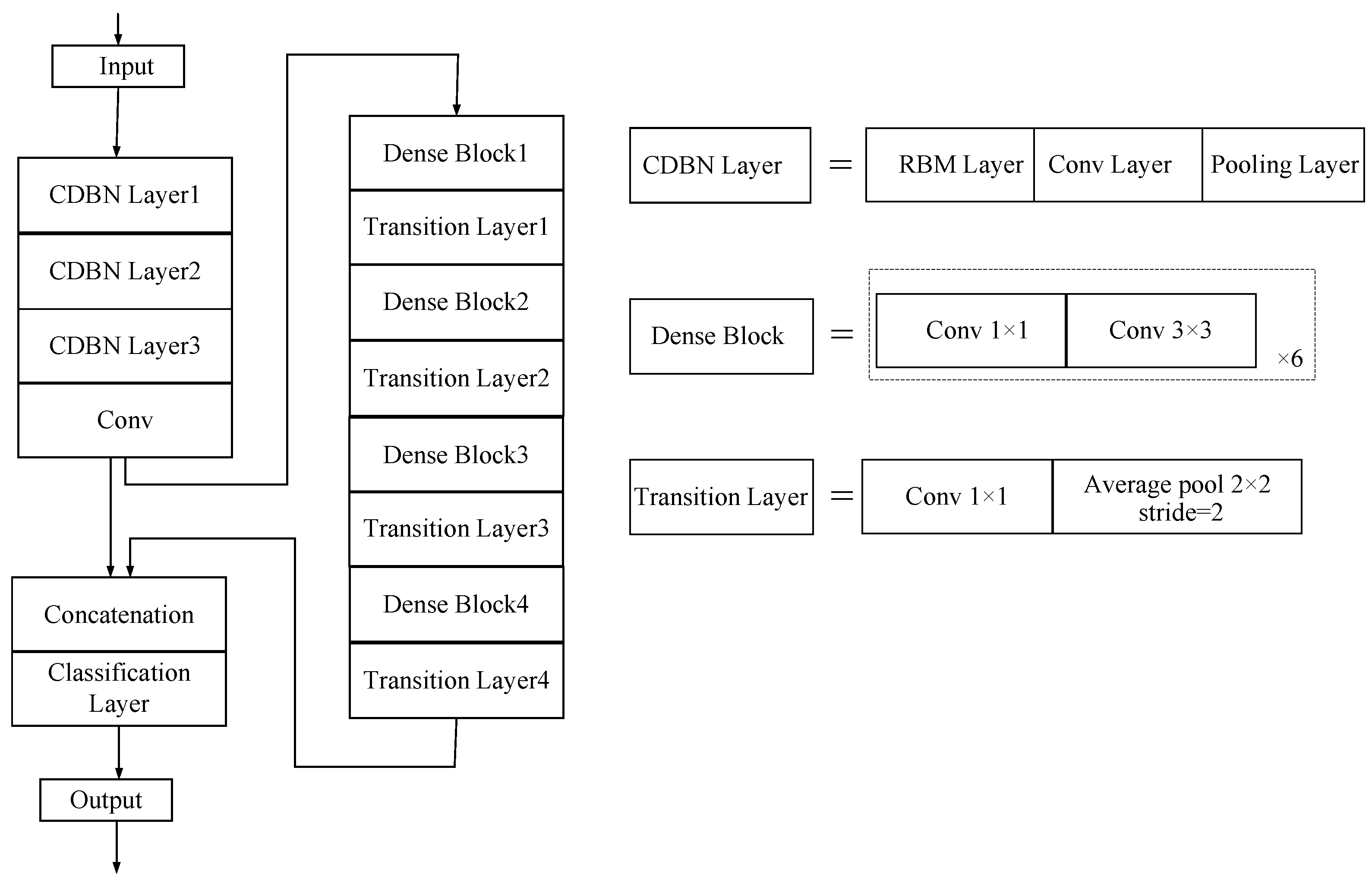
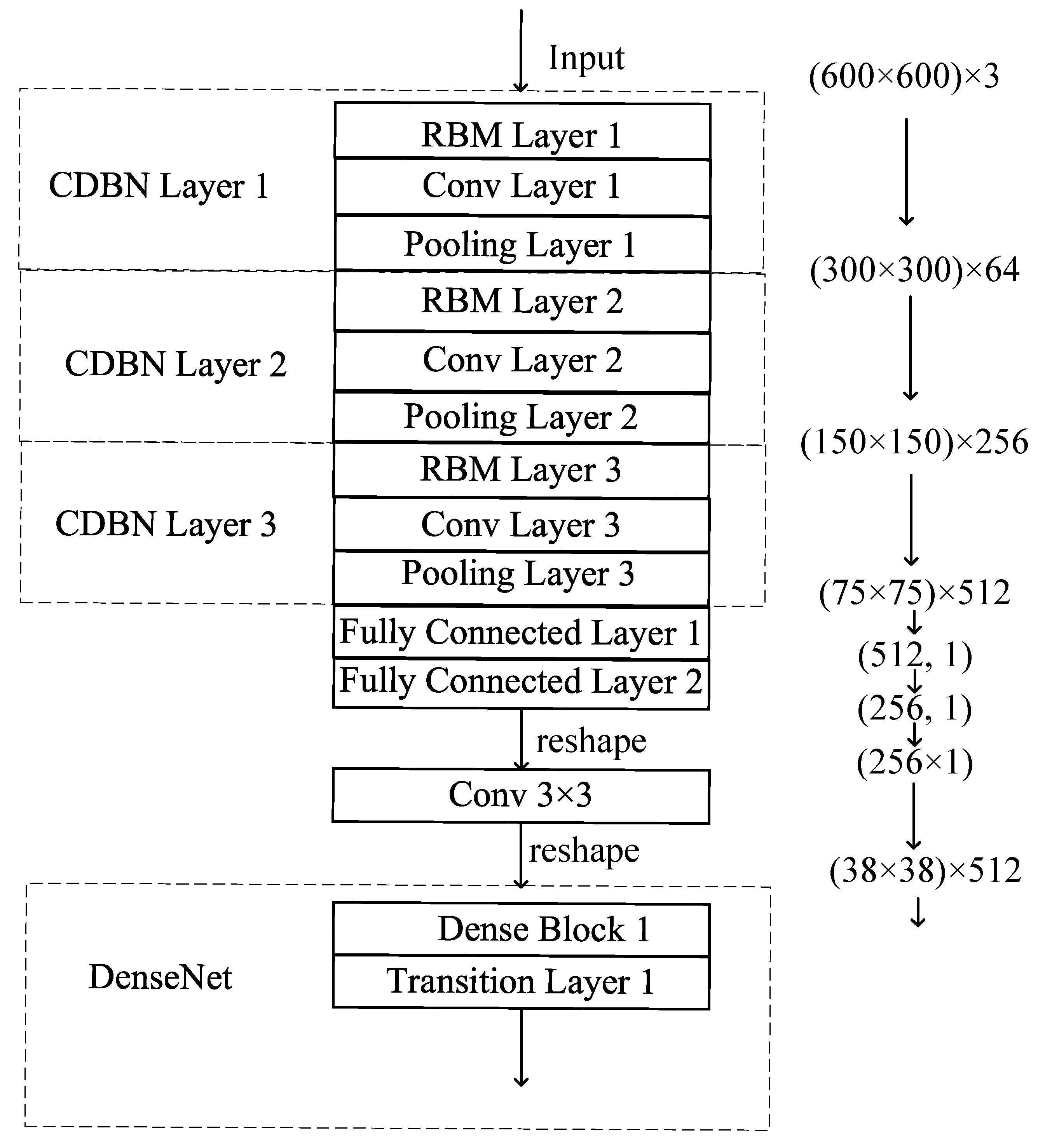
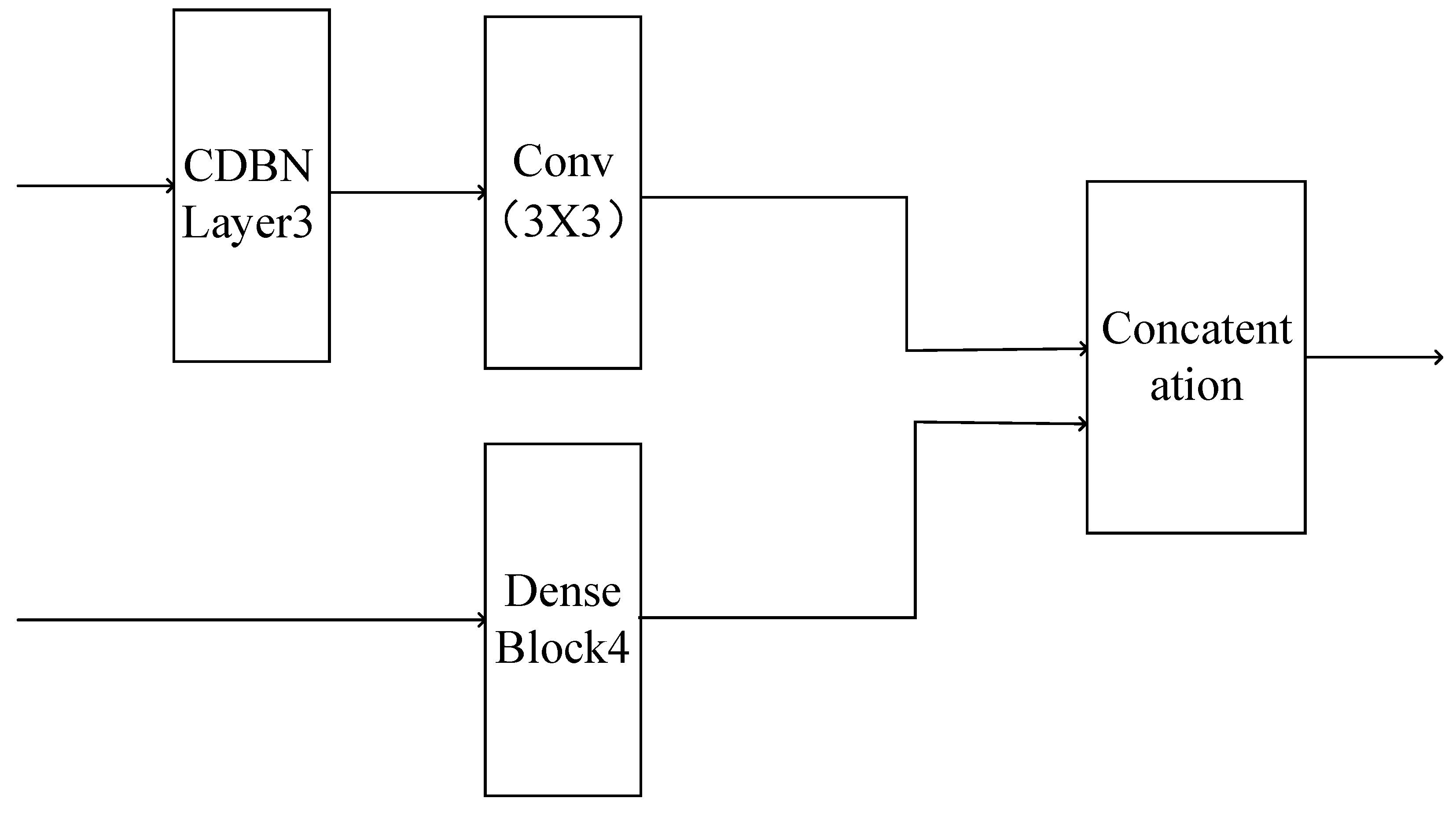
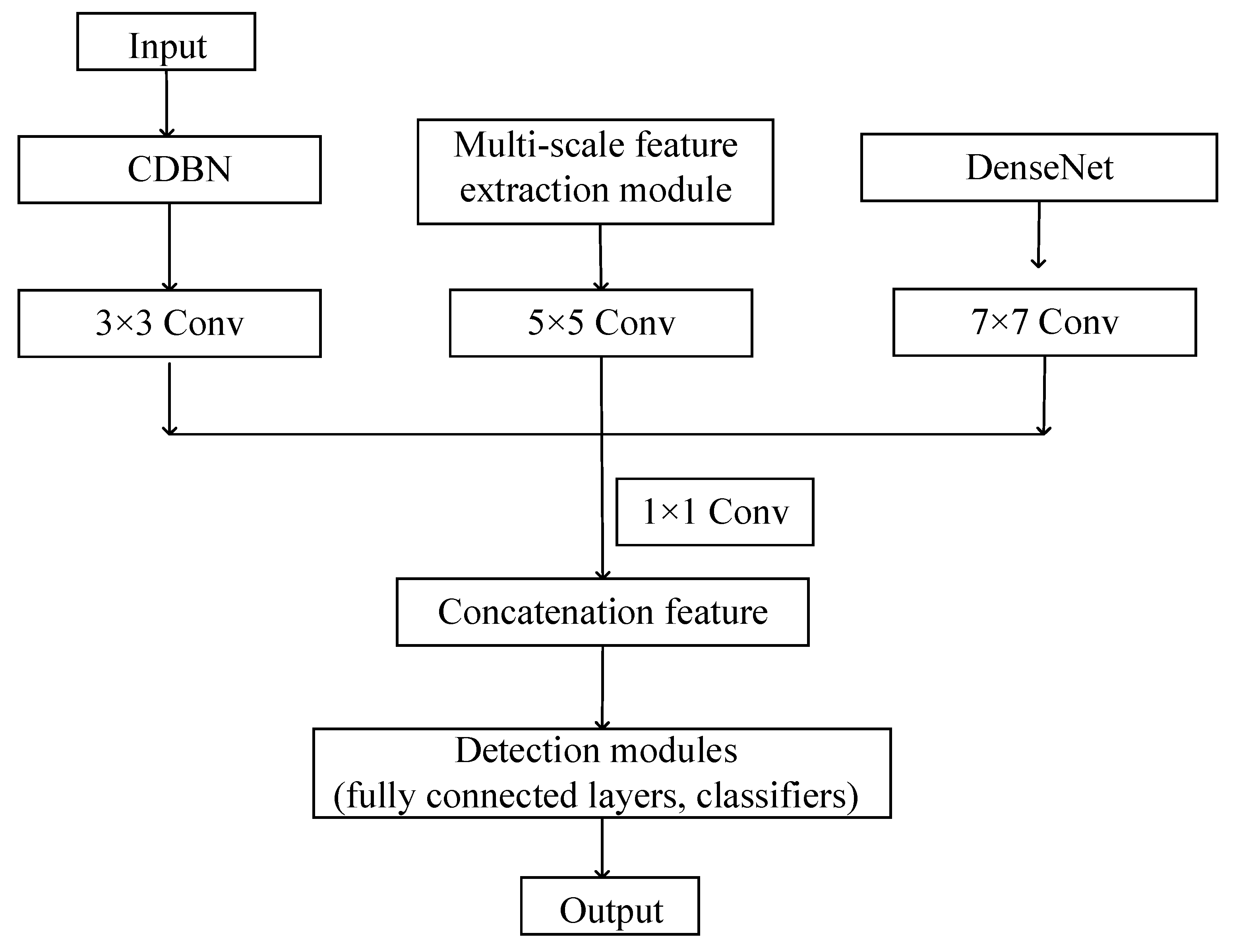
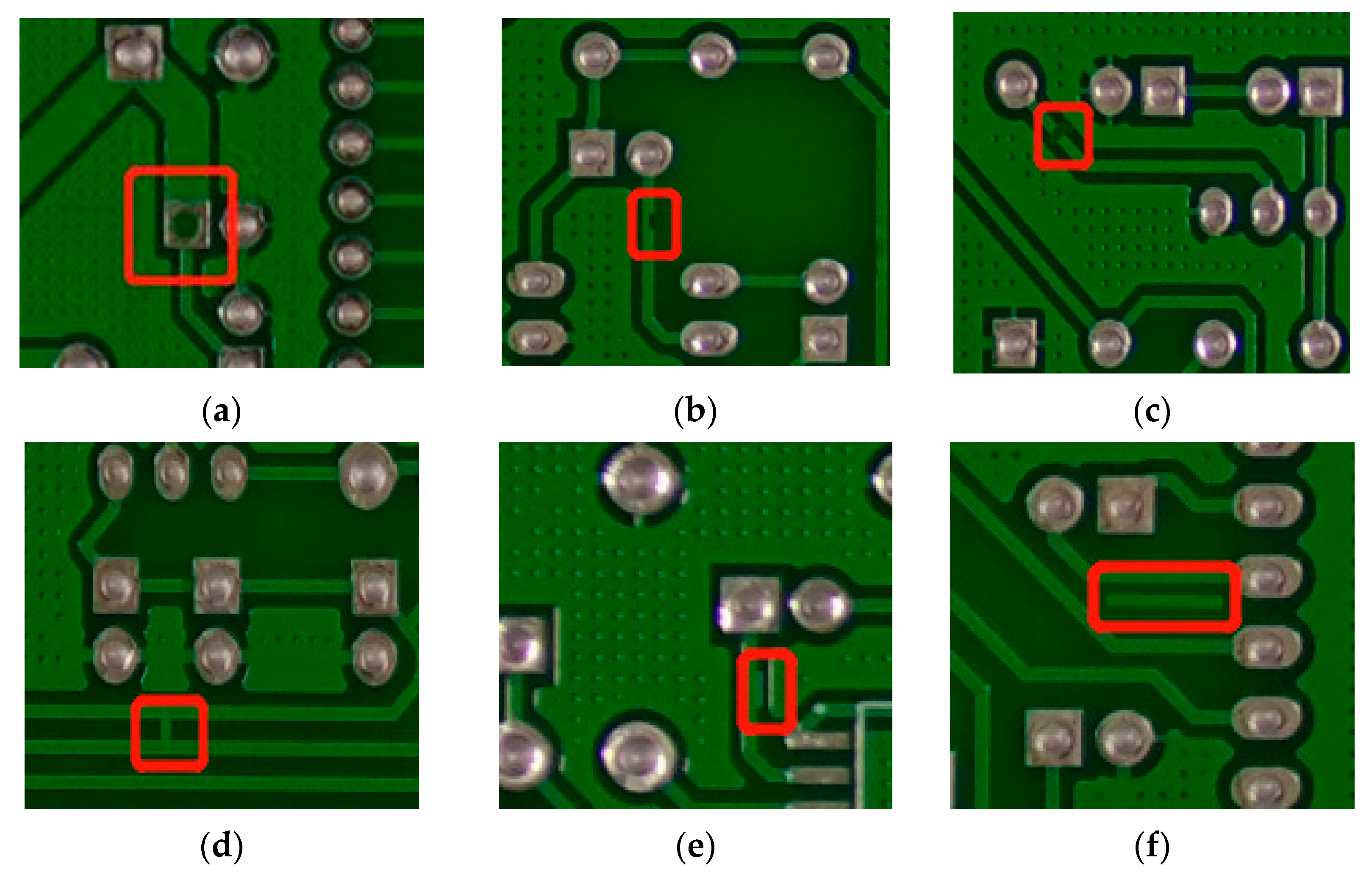
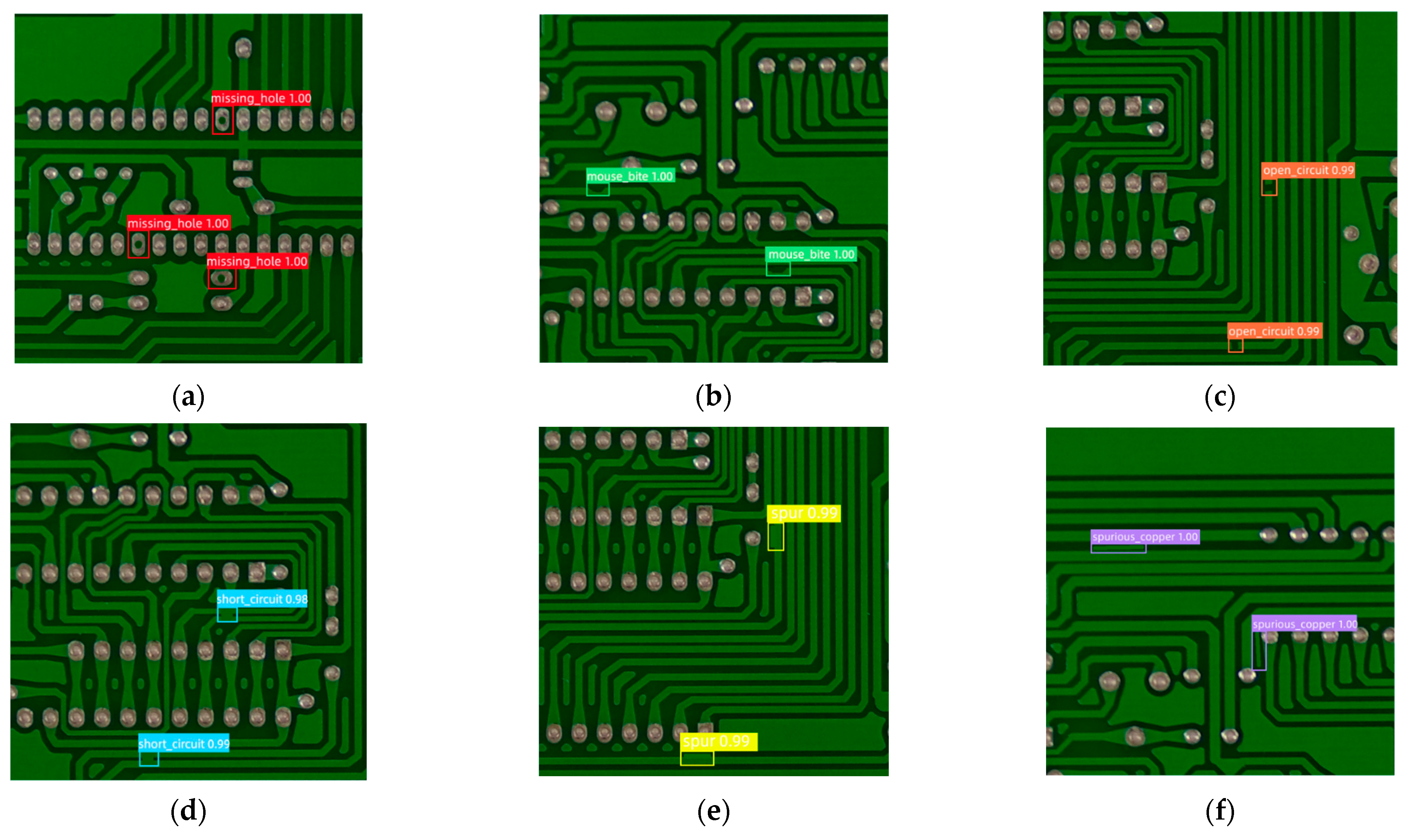
| Defect Type | Missing Hole | Mouse Bite | Open Circuit | Short Circuit | Spur | Spurious Copper |
|---|---|---|---|---|---|---|
| Number of pictures | 116 | 115 | 116 | 116 | 115 | 115 |
| Number of defects | 503 | 497 | 482 | 491 | 488 | 492 |
| Experiment | P/% | R/% | mAP/% | mAP.5:.95/% |
|---|---|---|---|---|
| DBN | 86.57 | 90.95 | 87.76 | 49.56 |
| DenseNet | 90.82 | 91.73 | 90.99 | 50.13 |
| D-DenseNet network with concatenation only and no further improvements | 91.43 | 92.46 | 91.74 | 50.29 |
| Experiment | P/% | R/% | mAP/% | mAP.5:.95/% |
|---|---|---|---|---|
| Original, unimproved D-DenseNet network | 91.43 | 92.46 | 91.74 | 50.29 |
| D-DenseNet network with added multi-scale feature extraction module | 91.90 | 93.65 | 92.78 | 50.35 |
| Experiment | P/% | R/% | mAP/% | mAP.5:.95/% |
|---|---|---|---|---|
| D-DenseNet network with concatenation only and no further improvements | 91.43 | 92.46 | 91.74 | 50.29 |
| Only adding the Adafactor optimization function | 91.67 | 92.73 | 92.18 | 50.31 |
| Only adding L2 regularization | 91.72 | 92.87 | 92.24 | 50.32 |
| Simultaneously adding the Adafactor optimization function and L2 regularization | 91.88 | 93.15 | 92.33 | 50.33 |
| Experiment | P/% | R/% | mAP/% | mAP.5:.95/% |
|---|---|---|---|---|
| D-DenseNet network with concatenation only and no further improvements | 91.43 | 92.46 | 91.74 | 50.29 |
| D-DenseNet network with the introduction of OHEM | 92.01 | 93.58 | 92.53 | 50.34 |
| Experiment | P/% | R/% | mAP/% | mAP.5:.95/% |
|---|---|---|---|---|
| D-DenseNet network with concatenation only and no further improvements | 91.43 | 92.46 | 91.74 | 50.29 |
| Adding Multi-Scale Feature Extraction Module | 91.90 | 93.65 | 92.78 | 50.35 |
| Adding Only Adafactor Optimization Function | 91.67 | 92.73 | 92.18 | 50.31 |
| Adding Only L2 Regularization | 91.72 | 92.87 | 92.24 | 50.32 |
| Introducing Hard Example Mining Mechanism (OHEM) | 92.01 | 93.58 | 92.53 | 50.34 |
| PCBDD-DDNet | 92.34 | 94.09 | 93.24 | 50.48 |
| Experiment | P/% | R/% | mAP/% | mAP.5:.95/% |
|---|---|---|---|---|
| CDBN | 86.57 | 90.95 | 87.76 | 49.56 |
| DenseNet | 90.82 | 91.73 | 90.99 | 50.13 |
| SSD512 | 85.36 | 88.79 | 88.45 | 48.07 |
| YOLOv3 | 87.20 | 89.16 | 89.28 | 49.58 |
| RetinaNet | 89.91 | 91.87 | 90.64 | 49.77 |
| Faster R-CNN | 91.67 | 92.48 | 91.66 | 50.21 |
| FPN | 91.81 | 92.97 | 92.03 | 50.27 |
| D-DenseNet | 92.34 | 94.09 | 93.24 | 50.48 |
Disclaimer/Publisher’s Note: The statements, opinions and data contained in all publications are solely those of the individual author(s) and contributor(s) and not of MDPI and/or the editor(s). MDPI and/or the editor(s) disclaim responsibility for any injury to people or property resulting from any ideas, methods, instructions or products referred to in the content. |
© 2023 by the authors. Licensee MDPI, Basel, Switzerland. This article is an open access article distributed under the terms and conditions of the Creative Commons Attribution (CC BY) license (https://creativecommons.org/licenses/by/4.0/).
Share and Cite
Kang, H.; Yang, Y. An Enhanced Detection Method of PCB Defect Based on D-DenseNet (PCBDD-DDNet). Electronics 2023, 12, 4737. https://doi.org/10.3390/electronics12234737
Kang H, Yang Y. An Enhanced Detection Method of PCB Defect Based on D-DenseNet (PCBDD-DDNet). Electronics. 2023; 12(23):4737. https://doi.org/10.3390/electronics12234737
Chicago/Turabian StyleKang, Haiyan, and Yujie Yang. 2023. "An Enhanced Detection Method of PCB Defect Based on D-DenseNet (PCBDD-DDNet)" Electronics 12, no. 23: 4737. https://doi.org/10.3390/electronics12234737
APA StyleKang, H., & Yang, Y. (2023). An Enhanced Detection Method of PCB Defect Based on D-DenseNet (PCBDD-DDNet). Electronics, 12(23), 4737. https://doi.org/10.3390/electronics12234737







